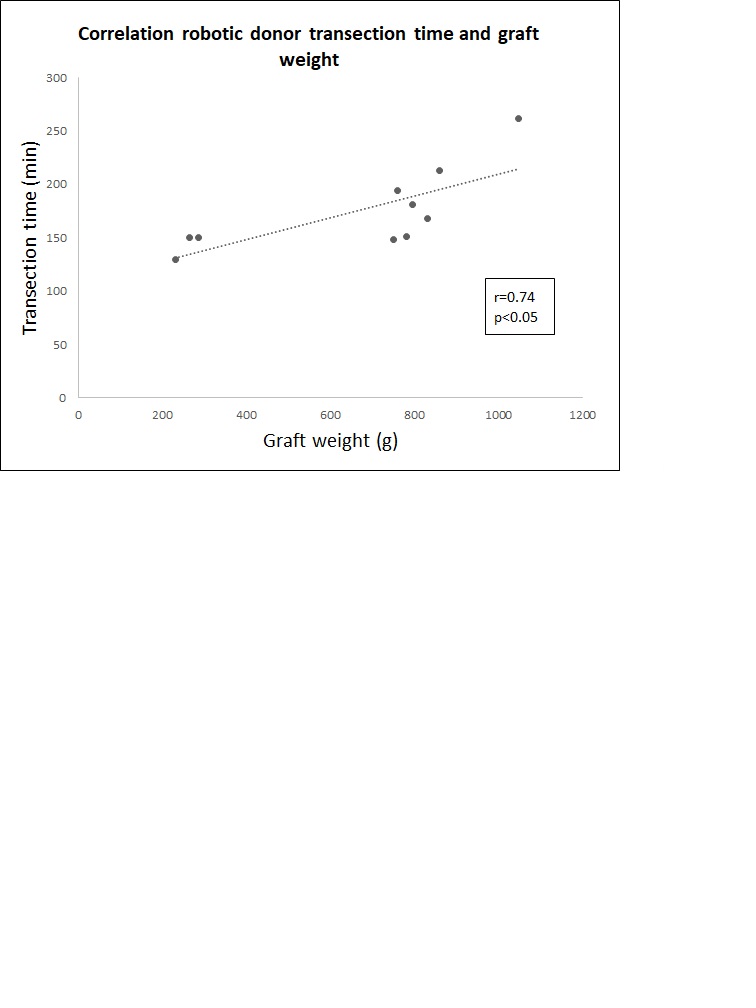Totally Robotic Living Donor Hepatectomy Graft Parenchymal Transection Time
Lahey Hospital & Medical Center, Burlington, MA
Meeting: 2020 American Transplant Congress
Abstract number: 472
Keywords: Liver transplantation, Living donor, Outcome, Surgical complications
Session Information
Session Name: Liver: Living Donors and Partial Grafts II
Session Type: Oral Abstract Session
Date: Saturday, May 30, 2020
Session Time: 3:15pm-4:45pm
 Presentation Time: 3:39pm-3:51pm
Presentation Time: 3:39pm-3:51pm
Location: Virtual
*Purpose: Evaluate duration of parenchymal transection in a series of totally robotic living donor hepatectomies in order to improve time coordination between living donor and recipient cases.
*Methods: In the initial 18 months of our robotic living donor hepatectomy program, we performed a total of 10 robotic donor hepatectomy cases (7 right lobe and 3 left lateral segment donors). Parenchymal transection was completed using a combination of robotic harmonic scalpel and bipolar electrocautery. Patient demographic data analyzed included age, gender, body mass index, and previous abdominal operations. Surgical data analyzed included parenchymal transection time, blood loss, graft weight (actual and predicted) and conversion to open. Transection time was defined as the period between the first division of parenchymal until a complete split from the remnant liver.
*Results: There were 8 female and 2 male donors. Average donor age and BMI were 40 years and 26.9 kg/m2 respectively. Four donors had previous abdominal operations including splenectomy, hysterectomy and cesarean sections. Mean graft weights were 832g (750-1047g) for right lobe and 260g (230-285g) for left lateral segment grafts. Average difference between actual to predicted graft weight was +0.78% and +16.6% for right lobe and left lateral segment grafts respectively. As expected, duration of parenchymal transection was longer for right lobe grafts (average 188min) compared to left lateral segment grafts (average 143min). Speed of transection was 4.5g/min vs 1.8g/min for right lobe vs left lateral segment grafts. Our transection speed improved with increased experience. There was a positive correlation between graft weight and parenchymal transection speed (r=0.74; p<0.05). There were no conversions to open procedure and estimated blood loss averaged 236mls.
*Conclusions: The data above may be helpful to predict the length of time required for parenchymal transection in totally robotic donor hepatectomy. The duration appears dependent on graft weight and program experience.
To cite this abstract in AMA style:
Cheah YL, Kim J, Simon CJ, Meade S, Jenkins R, Akoad ME. Totally Robotic Living Donor Hepatectomy Graft Parenchymal Transection Time [abstract]. Am J Transplant. 2020; 20 (suppl 3). https://atcmeetingabstracts.com/abstract/totally-robotic-living-donor-hepatectomy-graft-parenchymal-transection-time/. Accessed January 1, 2026.« Back to 2020 American Transplant Congress


